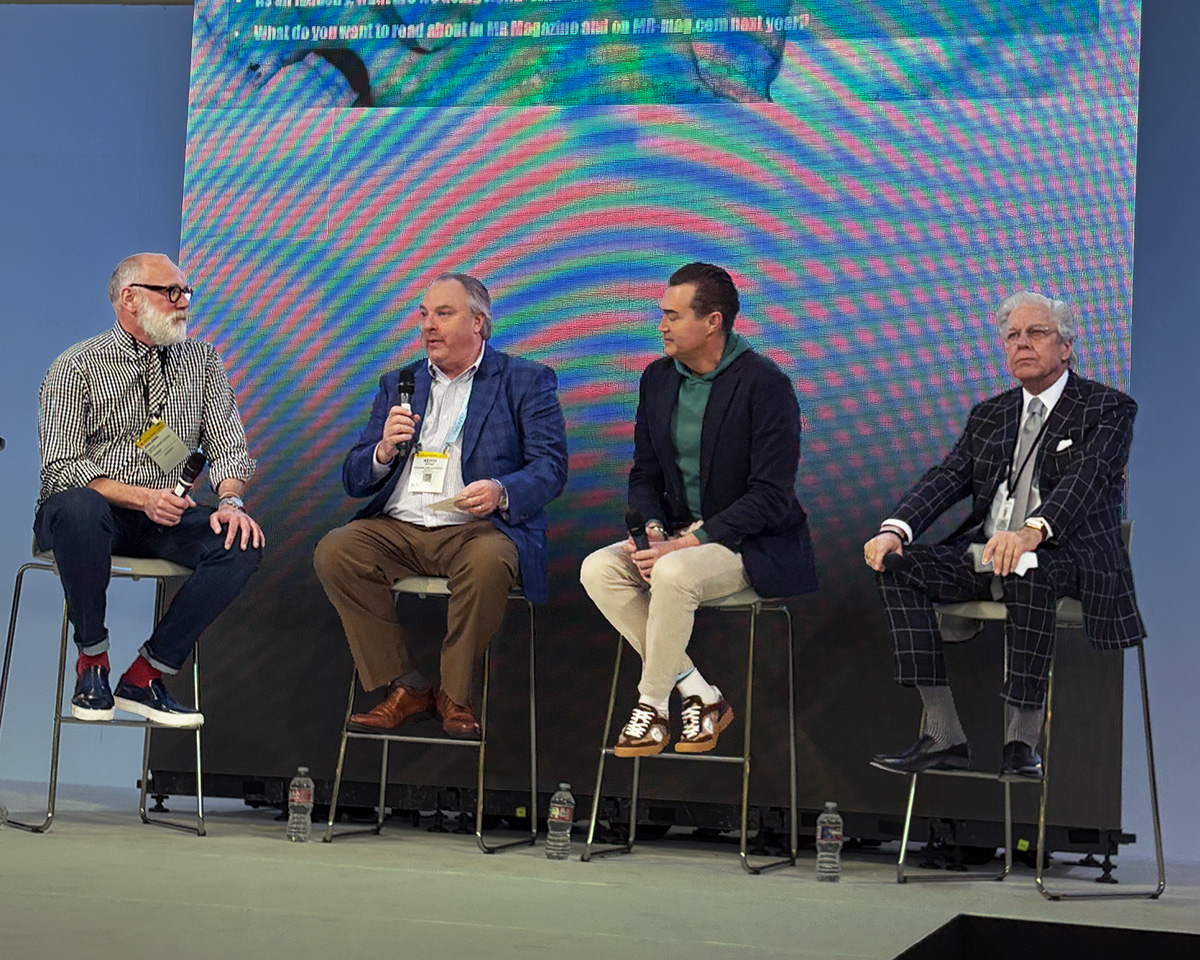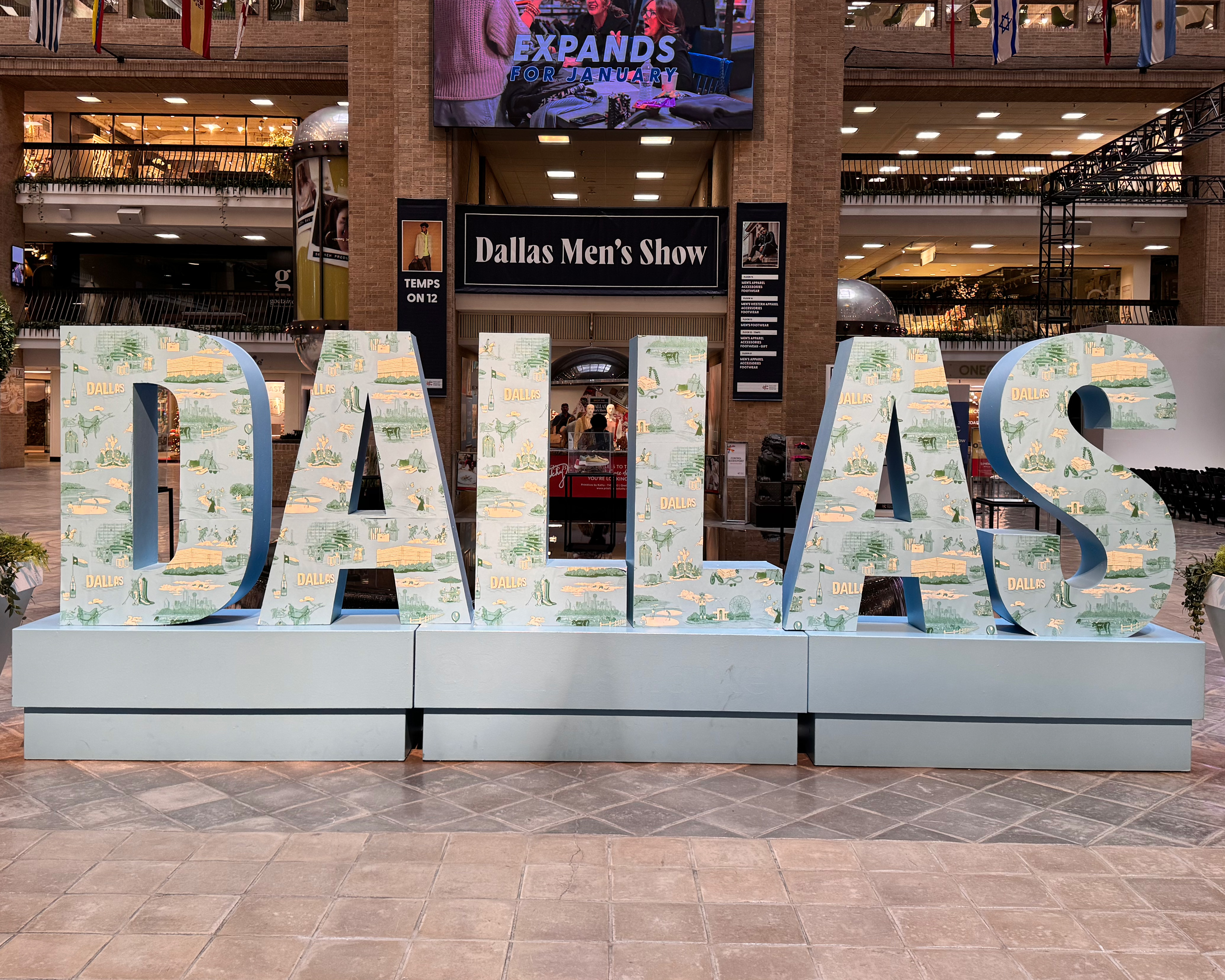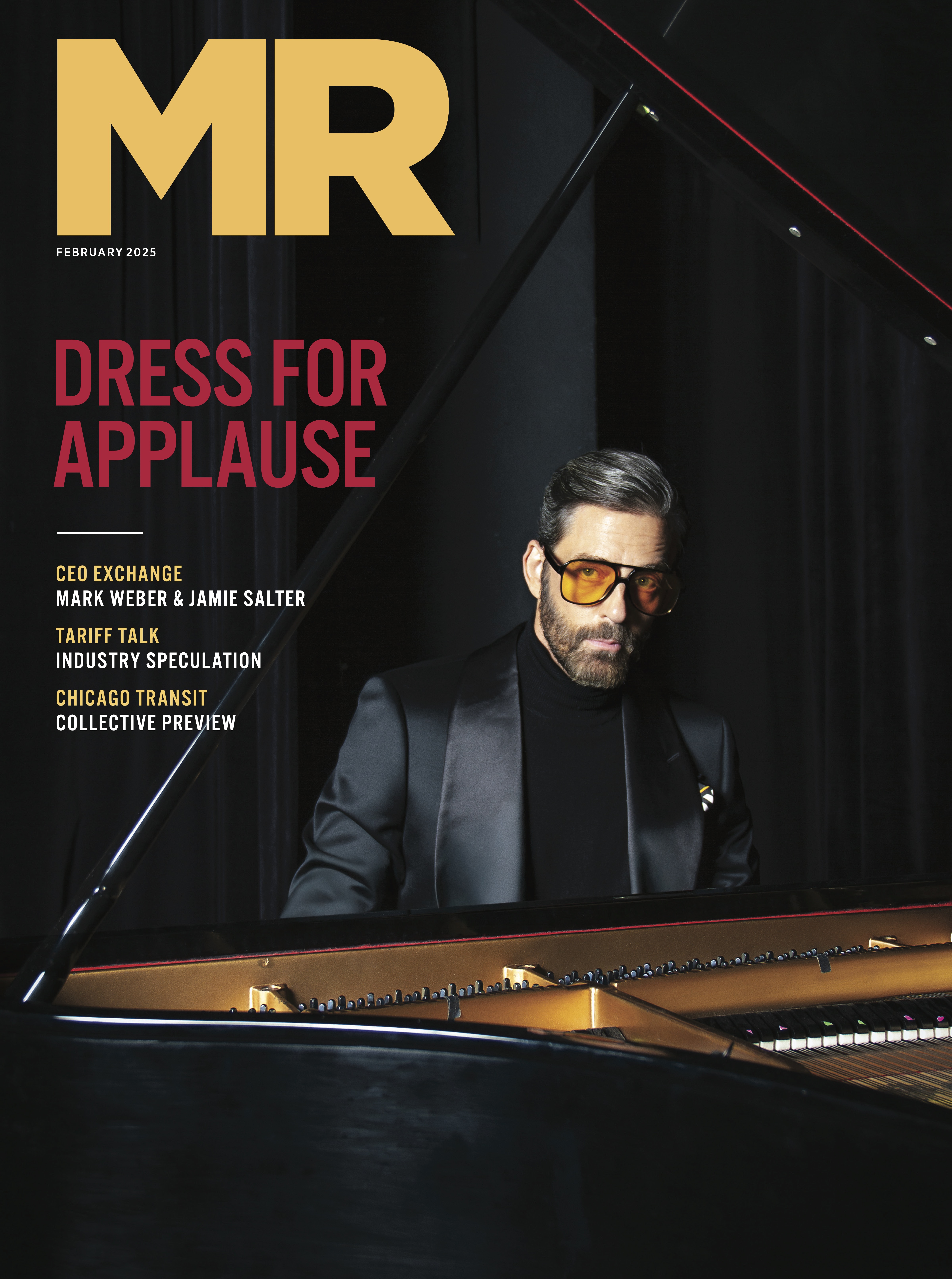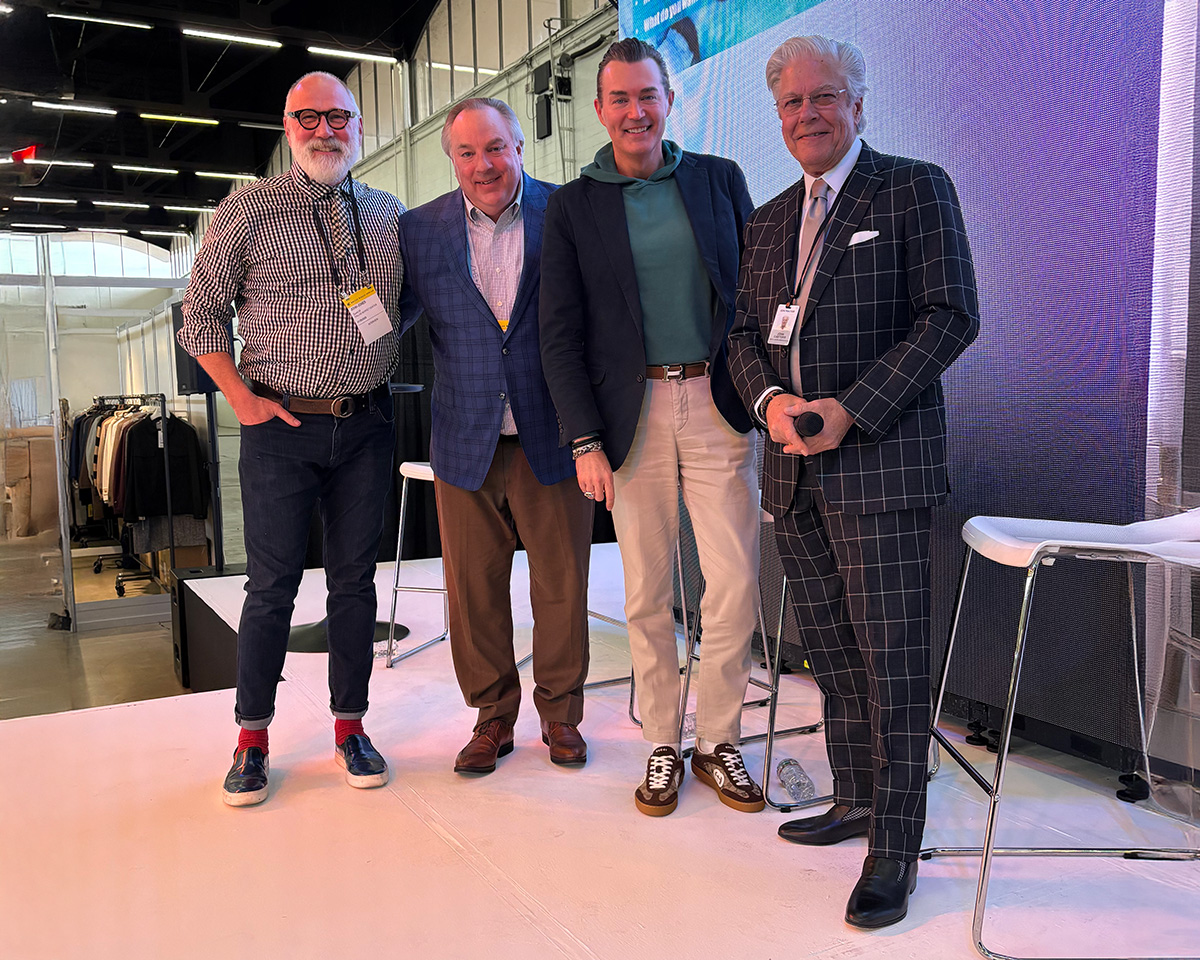“THREADS OF THOUGHT” A RETAIL PANEL FROM THE DALLAS MEN’S SHOW

The Dallas Market Center was kind enough to invite me to host a panel on issues in menswear retailing titled Threads of Thought at the Dallas Men’s Show on January 25th, 2025. Joining me on stage were Keith Kinkade, co-owner of Kinkade’s Fine Clothing in Ridgeland, Mississippi, Chuck Steelman, the chief customer and experience officer of Stanley Korshak, and John Castorr, menswear ambassador to the Dallas Mart, and proprietor of The Men’s Portfolio@Dallas. The four of us had a lively and informative discussion about the luxury market, tariffs, sustainability, customer service, and the ongoing importance of experiences in modern retail.
JRJ: We’re six days into the new Trump administration and all anybody wants to talk about are tariffs. How is that going to affect our business, especially since so much product in our business comes from Canada and Mexico?
Keith Kinkade: I’m going to optimistic! I think the new administration is going to look at the whole picture. Canadian corporations, and the country as a whole, are great partners with the United States in manufacturing. We’re great friends with our Canada-based brands, and have done business with them for 30 or 40 years. I’d like to see this administration do great things, and I understand we want to get everybody back to work. I’m for all that, but I’m not a fan of tariffs on Canadian goods.
Chuck Steelman: In the luxury space, I’m not sure the tariffs are going to affect us as drastically as it will items made in China. Fast fashion will really be affected. I’m also optimistic. I hope that some of the theater we hear throughout the political scene will be diminished and educated people will provide the proper guidance so that tariffs are done in the right way to make our country great, while keeping our economy moving.
JRJ: Steve Pruitt [of Black’s Consulting], one of our experts on the MR website, recently advised retailers to move towards the upper part of the market, perhaps even creating a new layer that is more upscale than what they usually sell. What’s your opinion?
CS: I’ve worked in this industry for 30 years, and just when you think things are expensive, there’s always more. Over the past decade, luxury has pushed the limits, and I believe it will continue as our economy grows and improves. Luxury retailers will keep pushing the envelope, exploring more luxurious fabrics and ways to make items more exclusive. In my business, everything is experiential. If you can offer a client an experience, it doesn’t matter how much they have to pay; they want it. I took a client to Italy to shop with Kiton, one of our top brands at Stanley Korshak. He spent over $200,000 because we provided a luxury experience that he couldn’t buy elsewhere. When you offer clients something unique and create unforgettable moments for them, it really rolls out the red carpet and builds their loyalty. They open their pocketbooks and get swept up in the excitement, which significantly boosts our sales. Experiential marketing is a crucial component of the luxury industry when considering ways to grow those businesses. But I know that when we’re selling suits for under $18,000 or $24,000, we are going to see those prices rise as designers create more luxurious items.
KK: Stanley Korshak is one of the greatest stores in the United States, if not the world. We, on the other hand, are a small store in Mississippi. I drive a pickup truck to work every day. The most expensive suit in our store probably costs $1,000. We still believe in offering value and excellent customer service, but we know we need to provide it at a price our customers can afford. We sell suits starting at $300 and pants starting at $59. We want every customer, whoever they may be, to have a great experience in our store, just as if I walked into Stanley Korshak or Chuck walked into ours. It’s all about the experience and the value customers find here. It’s the same principle.
CS: I’ll say this: working at Neiman Marcus, I’ve traveled all over the world with clients. You look at small towns—I grew up in Alabama, so I know about small towns—but my number one customer from the Beverly Hills Neiman Marcus store was from Dothan, Alabama, one of the smallest, most rural cities in our country. And I completely agree with what Keith says: You build your store based on who your customers are, but in the luxury space, they are everywhere. They don’t need to live in New York City or Los Angeles, California. They can reside in Dothan, Alabama, or Midland, Texas. Luxury customers can be found all over the United States. You just have to be relevant and offer something they can’t buy anywhere else, and you’ll earn their business.
John Castorr: Keith is selling $300 suits, and thinking about bringing $350 suits in this season. His $1,000 suits might be going up to $1,250, right? There’s some movement here for everybody. You need to pick it up and give them a reason to buy.

CS: I can talk a lot about sustainability. Sustainability is very important to younger generations. Unfortunately, our industry is the second biggest cause of environmental damage, with oil and gas being the first. Achieving sustainability is challenging. A store can do things like adjust its lighting to be more sustainable, but in the luxury market, again, it’s about quality. Now that there are so many resale options like The Real Real, customers can invest in items they know they can resell. Those items will likely end up in someone else’s closet for another 20 or 30 years. In contrast, fast fashion often ends up in a dumpster within a week because people wear it just once, and when it rips or stains—especially stains that won’t come out—it’s thrown away. We also know that the fabrics used in fast fashion are among the worst choices and are really harmful to the environment.
KK: I consider it from two perspectives: If we discover they’re creating sweaters from oyster shells or whatever it might be, we will buy that, and it turns into a storytelling opportunity for both the salesperson and the customer. The second aspect is how we, as a men’s store, can be more mindful about planning and everything we do. I have an older brother who joined the store and recycles everything. He makes sure all of our cardboard boxes are recycled, or we reuse them if they’re in good condition. If a shopping bag is still usable, he’ll fold it back up and reuse it. He’s only been with us for a couple of months, but it’s remarkable how much he’s highlighted what we weren’t doing.
CS: I want to say that it’s admirable how designers have creatively found sustainable new ways to dye fabrics. Some brands are using mushroom leather instead of real leather. Some of the processes end up making the product more expensive, but when we consider ways to improve how we do business, it can be challenging. Still, many brands are actively working on developing more sustainable options.
JC: Show your customers something new! I saw cowboy boots made from fish skin! They’re quite unusual and, again, provide something new to talk about.
JRJ: How are we doing right now with the trade show/supply chain/delivery calendar? Is everything coming in when it should be?
JC: I think they are. We’ve been through a rough period. This mart was the only one open in the country during COVID. We’ve learned a lot, and it’s always getting easier.
CS: When I consider delivery seasons, I feel they need to disappear. Customers want to buy things immediately; they don’t want to wait six months. The industry has attempted to address this by allowing customers to see items on the runway and purchase them right away instead of waiting six to eight months. From a retail and fashion perspective, I prefer seasonless merchandise that’s available year-round, making delivery schedules irrelevant. It’s all about offering something that customers can purchase. People shouldn’t think, “I can only buy this because it’s fall,” or “I can only buy this because it’s resort,” Or “I can only buy this because it’s spring.” I believe we should aim for a seasonless approach, which would make delivery issues less significant. Your inventory should reflect what customers are buying right now.
KK: In Mississippi, we’re trying to find stuff that’s year-round for our customers. Don’t get me wrong, we’re still going to want a leather coat or a cool sweater that might not be wearable in August in Mississippi or here in Texas, but I love fall clothes! I love the fall season. I love the leaves changing. We’re here, buying for fall of next year, and I understand that the manufacturers have to make it and get it delivered, but if it’s late, all they have to do is pick up a phone and call us and we’ll work with them! The relationship with the vendor and the stores is key. Dallas is probably one of the best marts that puts the vendor and the retailer together and continues to build great relationships so that we can continue to move product to our customers.
JC: May I talk about another trend. How many of you out there have been using AI chatbots? You know your customer is using them to learn about fashion. They want to know what they should wear. You can ask it about what politicians are wearing, or where celebrities you admire shop. Simple style questions like what neckwear options are there to wear with a tuxedo. If you know that you saw a suit that you liked in the Wall Street Journal, but you can’t remember whose it was, you can ask it what brands have advertised there.

CS: I like to say, for men’s fashion, don’t forget about your core client, the gentleman customer. You might think men no longer wear suits, but I disagree. When millennials started moving into fashion, it took men’s fashion to a whole new level. Now, many department stores have moved away from the gentleman customer and brought in a lot of trend-driven merchandise, which is great, but stay true to that customer and think about their lifestyle. Guys are always going to need a suit; they’re always going to need a tuxedo. Any store in the United States should have these items.
KK: I agree 100%. I still wear a dress shirt and a sport coat or a suit to church every Sunday. Men need a suit to wear to a funeral or to a wedding; people are always going to get married and, unfortunately, people are not going to be with us anymore. I still see a great market out there in suits and sport coats and other dress-up wear, whatever the price point it may be. I think we’re going to see moving forward a trend towards very Americana, back to work, back at the office, back to dressing again, wearing coats, suits,and ties. I really think this administration is going to push it hard and make America without it being a cliche.
CS: The merchandise is the first part of the whole experience for a customer, but you have to offer something more. You have to have the right merchants for a store finding the right items that the clients want to buy, but you have to also think about the competition. Technology has changed everything in our business, just like John was just showing us with AI. You can buy a suit from your phone while sitting on the subway in New York City. What are you going to do to get the client into your store? How will you dangle your merchandise in front of them so that they don’t just go to any old website while sitting at their desk on their lunch break? Retailers really have to look at ways that they can offer experiential opportunities for customers to get them into the brick-and-mortar stores.
From my time at Neiman Marcus, I know that Millennial men are the best customers. When we’d get a new delivery of shoes, they’d come in and buy one pair. Then, when the same brand came in with four new styles, they’d come back and buy all four. They like to be dressed up. They like to be romanced. They like to be told what to wear. They want to be given champagne. They want to go to a fashion show. The older generation, really, their wives bought for them. Think about how to get those ladies back in, buying for their husbands. It’s not just about customer service and great merchandise. What can you offer that they can’t buy anywhere else? What’s going to make them get in their car, and drive five miles, whether it’s raining or snowing or in a heatwave? What are you going to offer them to get them into your store?
I’m already looking forward to catching up with these guys again at the next Dallas Men’s Show, July 26th to 28th, 2025, at the Dallas Market Center. Thank you so much, Keith, Chuck, and John for sharing your expertise and insight; and a special thank you to the team at the DMC, for hosting us.


